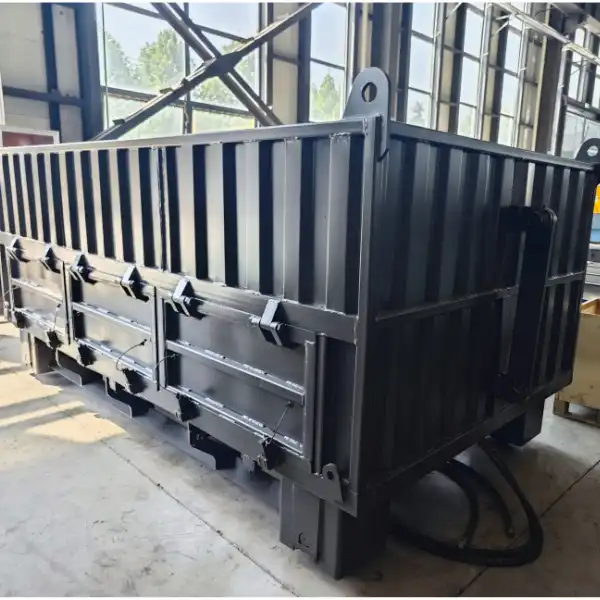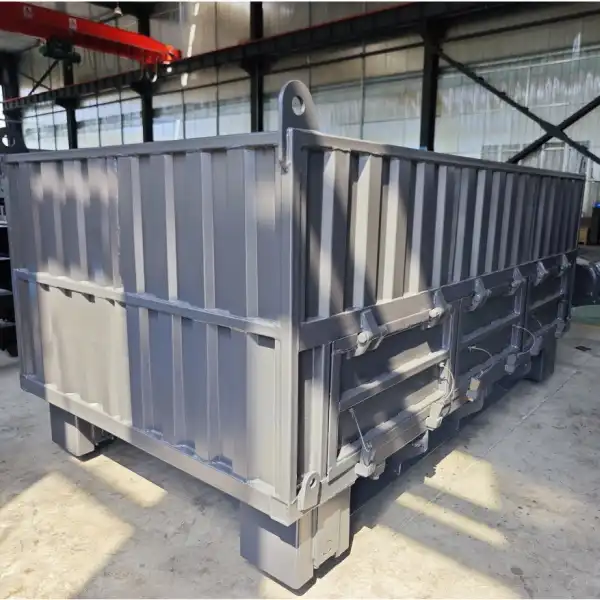How are the dimensions and capacity of railway ballast cars determined?
The dimensions and capacity of a railroad ballast car are meticulously calculated through a complex interplay of engineering standards, operational requirements, and safety regulations. Railway maintenance engineers determine these specifications by analyzing track gauge limitations, ballast material density, distribution patterns, and the mechanical constraints of existing rail infrastructure. The capacity calculation involves precise measurements of ballast volume requirements per track section, considering factors such as ballast depth beneath sleepers, shoulder width specifications, and drainage considerations. Modern ballast car rail designs typically range from 1,750 to 2,300 cubic feet in capacity, with dimensions carefully optimized to ensure efficient ballast distribution while maintaining structural integrity under dynamic loading conditions. These calculations directly impact maintenance efficiency, operational costs, and track longevity, making proper dimensional planning crucial for successful railway operations.

Rigid Restrictions On Railway Limits
Loading Gauge Constraints and Clearance Requirements
Railroad ballast car dimensions must conform to strict loading gauge specifications that vary across different rail networks worldwide. These clearance envelopes define the maximum height, width, and length permissible for rolling stock, directly influencing the car's structural design and capacity limitations. The loading gauge restrictions typically allow for a maximum car width of approximately 3,200 to 3,400 millimeters, depending on the specific railway system's standards.
Engineers must account for dynamic envelope considerations, where the car's movement during operation creates additional clearance requirements beyond static dimensions. Track curvature, superelevation, and vehicle dynamics all contribute to the effective space available for ballast car design. These restrictions fundamentally shape the car's profile, often requiring innovative hopper designs to maximize volume within constrained dimensions.
Axle Load Limitations and Weight Distribution
The structural design of railroad ballast car faces stringent axle load restrictions that directly impact both capacity and dimensional specifications. Most mainline railways impose axle load limits ranging from 20 to 30 tons per axle, necessitating careful distribution of ballast weight across multiple axles. This requirement influences the car's length, as longer cars can distribute weight more effectively while maintaining acceptable axle loadings.
Weight distribution calculations must consider the density of ballast materials, which typically ranges from 1.4 to 1.6 tons per cubic meter for crushed stone ballast. The car's structural framework must accommodate these loads while maintaining adequate safety margins under dynamic conditions, including acceleration, braking, and track irregularities that amplify loading forces.
Coupling and Buffer System Integration
Railway coupling systems impose additional dimensional constraints on ballast car design, particularly affecting the car's overall length and end configurations. Standard coupling arrangements require specific buffer heights, draw gear positioning, and coupler pocket dimensions that must integrate seamlessly with the car's structural framework. These requirements often dictate minimum and maximum car lengths to ensure proper train handling characteristics.
The integration of modern safety systems, including electronic braking and monitoring equipment, adds complexity to dimensional planning. These systems require dedicated space allocation while maintaining the car's primary function of ballast transport and distribution, often necessitating creative packaging solutions within the restricted dimensional envelope.
Key Logic For Capacity Determination
Ballast Volume Requirements Analysis
Capacity determination begins with comprehensive analysis of ballast volume requirements for typical track maintenance operations. Railway engineers calculate the volume of ballast needed per kilometer of track, considering factors such as sleeper spacing, ballast depth specifications, and shoulder width requirements. Standard ballast depths range from 200 to 400 millimeters beneath sleepers, with additional material required for shoulders and drainage layers.
The calculation methodology involves precise geometric analysis of track cross-sections, accounting for variations in ballast requirements across different track configurations. Single-track sections typically require approximately 800 to 1,200 cubic meters of ballast per kilometer, while double-track installations may require up to 2,000 cubic meters per kilometer. These requirements directly influence the optimal capacity range for railroad ballast car fleets.
Operational Efficiency Optimization
Capacity determination must balance material transport efficiency with operational flexibility. Larger capacity cars reduce the number of trips required for major ballast renewal projects but may prove less maneuverable for localized maintenance operations. Engineers analyze typical maintenance scenarios to determine the optimal capacity range that maximizes operational efficiency while maintaining versatility.
The relationship between car capacity and unloading characteristics plays a crucial role in capacity optimization. Ballast distribution patterns must ensure uniform material placement across track sections, requiring careful consideration of discharge door spacing, hopper geometry, and material flow characteristics. These factors influence the car's internal volume distribution and overall capacity utilization efficiency.
Material Handling and Flow Dynamics
Ballast material flow characteristics significantly impact capacity determination and internal car geometry. Crushed stone ballast exhibits specific flow properties that influence hopper design, discharge door sizing, and internal flow patterns. Engineers must consider the angle of repose, particle size distribution, and moisture content effects on material handling performance.
The design of discharge systems requires careful analysis of material flow rates to ensure consistent ballast distribution during operation. Variable discharge rates may be necessary to accommodate different track configurations and maintenance requirements, influencing the car's internal compartmentalization and capacity allocation strategies.

Application Of High-Strength Materials
Structural Steel Selection and Properties
Modern railroad ballast cars utilize high-strength structural steels that enable lightweight construction while maintaining exceptional durability under demanding operational conditions. Advanced steel alloys with yield strengths exceeding 350 MPa allow for thinner wall sections and reduced structural weight, effectively increasing payload capacity within existing dimensional constraints. These materials undergo rigorous testing to ensure fatigue resistance under cyclic loading conditions typical of railway operations.
The selection of appropriate steel grades involves a comprehensive analysis of material properties, including tensile strength, impact resistance, and weldability characteristics. Weathering steels are increasingly popular for ballast car construction due to their superior corrosion resistance, reducing maintenance requirements and extending service life. The material selection process must consider the harsh operating environment, including exposure to moisture, chemical contaminants, and mechanical wear from ballast handling operations.
Advanced Manufacturing Techniques
Contemporary ballast car manufacturing employs sophisticated fabrication techniques that optimize material utilization while enhancing structural performance. Laser cutting technology enables precise component shaping, reducing material waste and improving fit-up accuracy during assembly. Advanced welding processes, including gas metal arc welding and submerged arc welding, ensure high-quality joints that maintain structural integrity under dynamic loading conditions.
Computer-aided design and finite element analysis tools allow engineers to optimize structural configurations, identifying stress concentrations and optimizing material distribution throughout the car's framework. These analytical capabilities enable the development of lightweight yet robust designs that maximize capacity while ensuring long-term durability and safety compliance.
Protective Coating Systems
High-performance protective coating systems play a crucial role in maintaining the structural integrity of railroad ballast car components throughout their operational lifespan. Modern coating technologies include zinc-rich primers, epoxy intermediate coats, and polyurethane topcoats that provide multi-layer protection against corrosion and mechanical damage. These systems require careful surface preparation and application procedures to ensure optimal adhesion and performance.
The selection of appropriate coating systems considers the specific environmental challenges faced by ballast cars, including exposure to abrasive materials, temperature variations, and chemical contaminants. Advanced coating formulations incorporate ceramic particles and corrosion inhibitors that enhance wear resistance and extend coating life, reducing maintenance costs and improving overall car reliability.
FAQ
①What is the typical capacity range for modern railroad ballast cars?
Modern railroad ballast car capacities typically range from 1,750 to 2,300 cubic feet, with some specialized cars reaching up to 2,500 cubic feet. The specific capacity depends on the intended application, with smaller cars suited for localized maintenance and larger cars optimized for major ballast renewal projects.
②How do weight restrictions affect ballast car design?
Axle load limitations directly impact ballast car capacity and dimensional specifications. Most railways impose 20-30 ton per axle limits, requiring careful weight distribution across multiple axles. This necessitates longer car designs to accommodate larger capacities while maintaining acceptable axle loadings.
③What materials are used in modern ballast car construction?
High-strength structural steels with yield strengths exceeding 350 MPa are commonly used, along with weathering steels for enhanced corrosion resistance. Advanced protective coating systems provide additional protection against harsh operating environments.
④How are discharge systems designed for optimal ballast distribution?
Discharge systems incorporate multiple doors with precise spacing to ensure uniform material distribution. The design considers material flow characteristics, discharge rates, and track configuration requirements to optimize ballast placement efficiency.
⑤What role do clearance restrictions play in car dimensions?
Loading gauge specifications define maximum permissible dimensions, typically limiting car width to 3,200-3,400mm. Dynamic envelope considerations for vehicle movement during operation further constrain the available design space, requiring innovative hopper configurations to maximize capacity.
Thank you for your attention to Tiannuo's ballast car. Our railroad ballast car boasts a bucket capacity of 5.5m³, with dimensions of 3300mm in width, 1500mm in height, and 1850mm in depth. It is made of high-strength steel and features a leakage method of ballast on both sides and at the bottom. Behind the determination of railway ballast car dimensions and capacity lies sophisticated engineering principles, which are crucial for modern railway maintenance equipment. These principles balance operational requirements, safety regulations, and material constraints to drive innovation in design, ensuring efficient and reliable track maintenance operations and directly impacting the effectiveness of railway infrastructure maintenance.
The continuous integration of advanced materials, sophisticated design methodologies, and operational optimization strategies is enhancing the performance and efficiency of ballast cars. As railway networks evolve to meet growing demands for freight and passenger services, the importance of well-designed maintenance equipment becomes increasingly critical for safe and reliable transportation infrastructure.
For railway construction companies, maintenance contractors, and infrastructure managers in search of reliable ballast handling solutions, understanding these design principles is essential for informed equipment selection and operational planning. Considering capacity requirements, dimensional constraints, and material specifications ensures optimal performance and long-term reliability in demanding railway environments.
If you wish to learn more about our products, please don't hesitate to contact us at arm@stnd-machinery.com.
References
- American Railway Engineering and Maintenance-of-Way Association. "Manual for Railway Engineering: Track Design and Construction Standards." 2023 Edition.
- International Union of Railways. "Railway Ballast Car Specifications and Performance Requirements." Technical Report UIC-712R, 2024.
- Federal Railroad Administration. "Track Safety Standards and Ballast Requirements for Freight Operations." CFR Title 49, Part 213, 2024.
- European Committee for Standardization. "Railway Applications - Track - Ballast Cars and Maintenance Equipment." EN 13848-6:2024.
- Association of American Railroads. "Manual of Standards and Recommended Practices: Freight Car Design and Construction." Section M-1001, 2024 Edition.
About Author: Arm
Arm is a leading expert in the field of specialized construction and railway maintenance equipment, working at Tiannuo Company. Tiannuo specializes in manufacturing a wide range of products, including railway maintenance equipment like railway sleeper changing machines and screening machines, excavator modification equipment such as excavator lifting cabs, various engineering arms for excavators, excavator accessories like digging buckets, and engineering vehicle auxiliary equipment like loader buckets.

